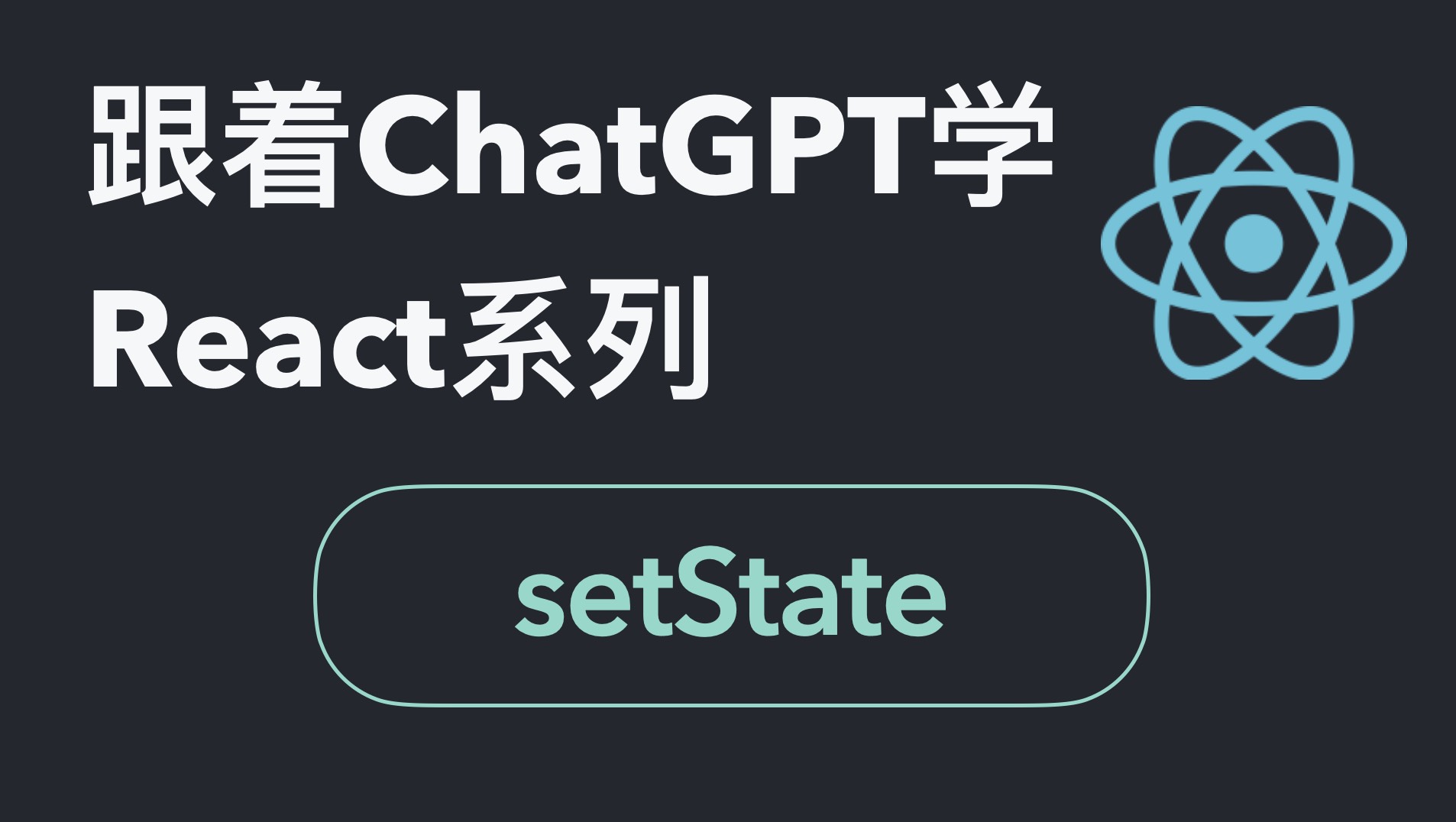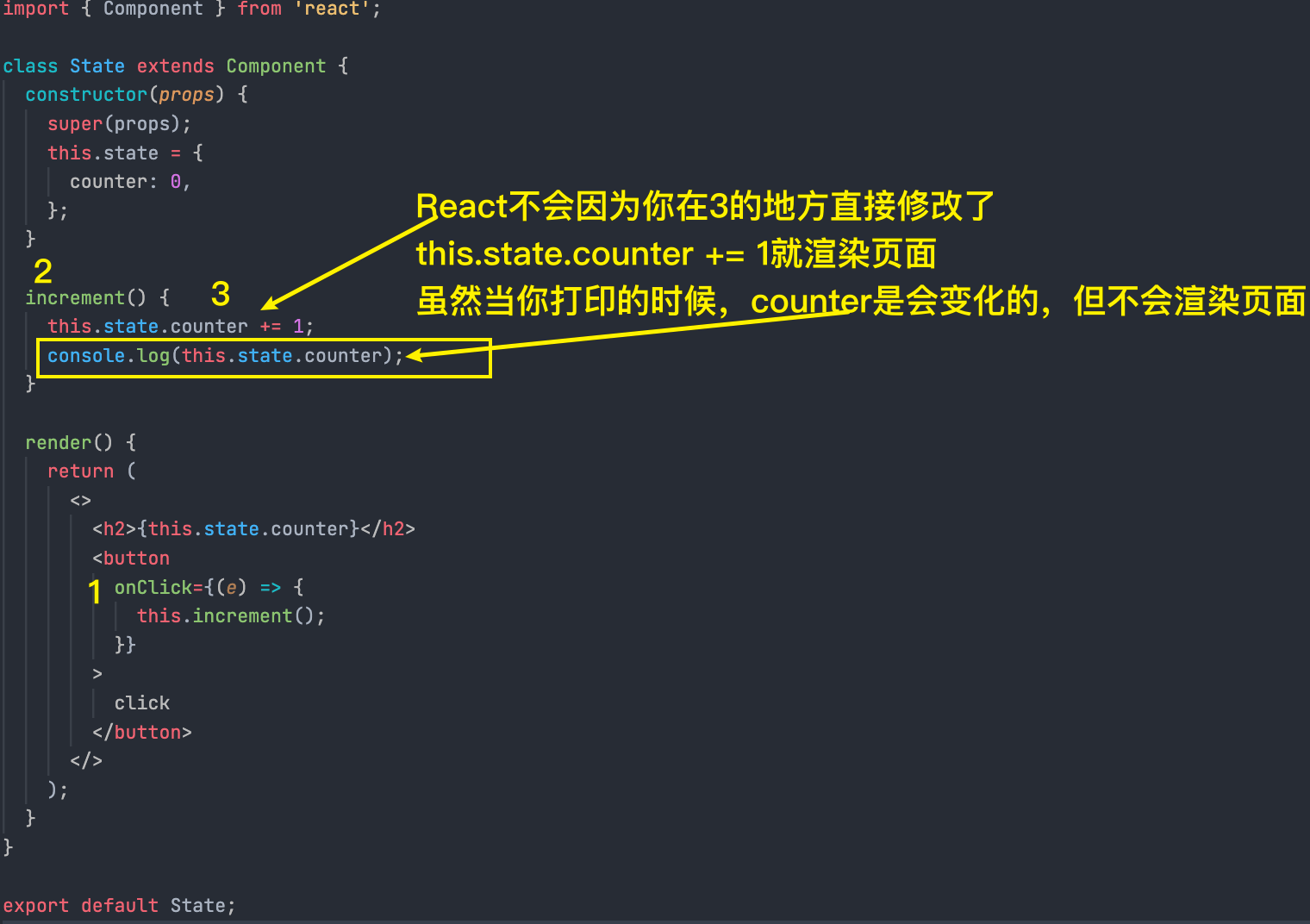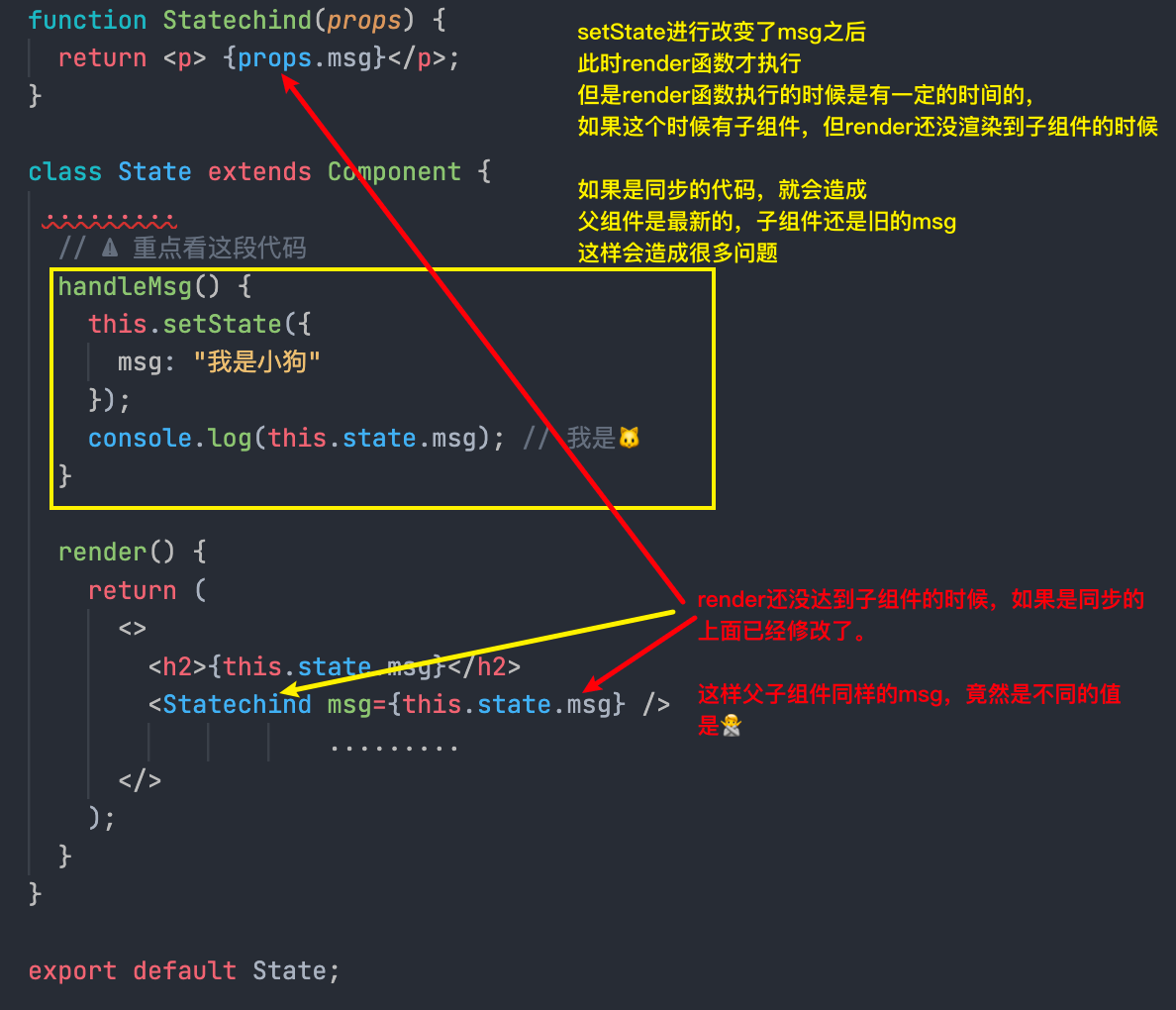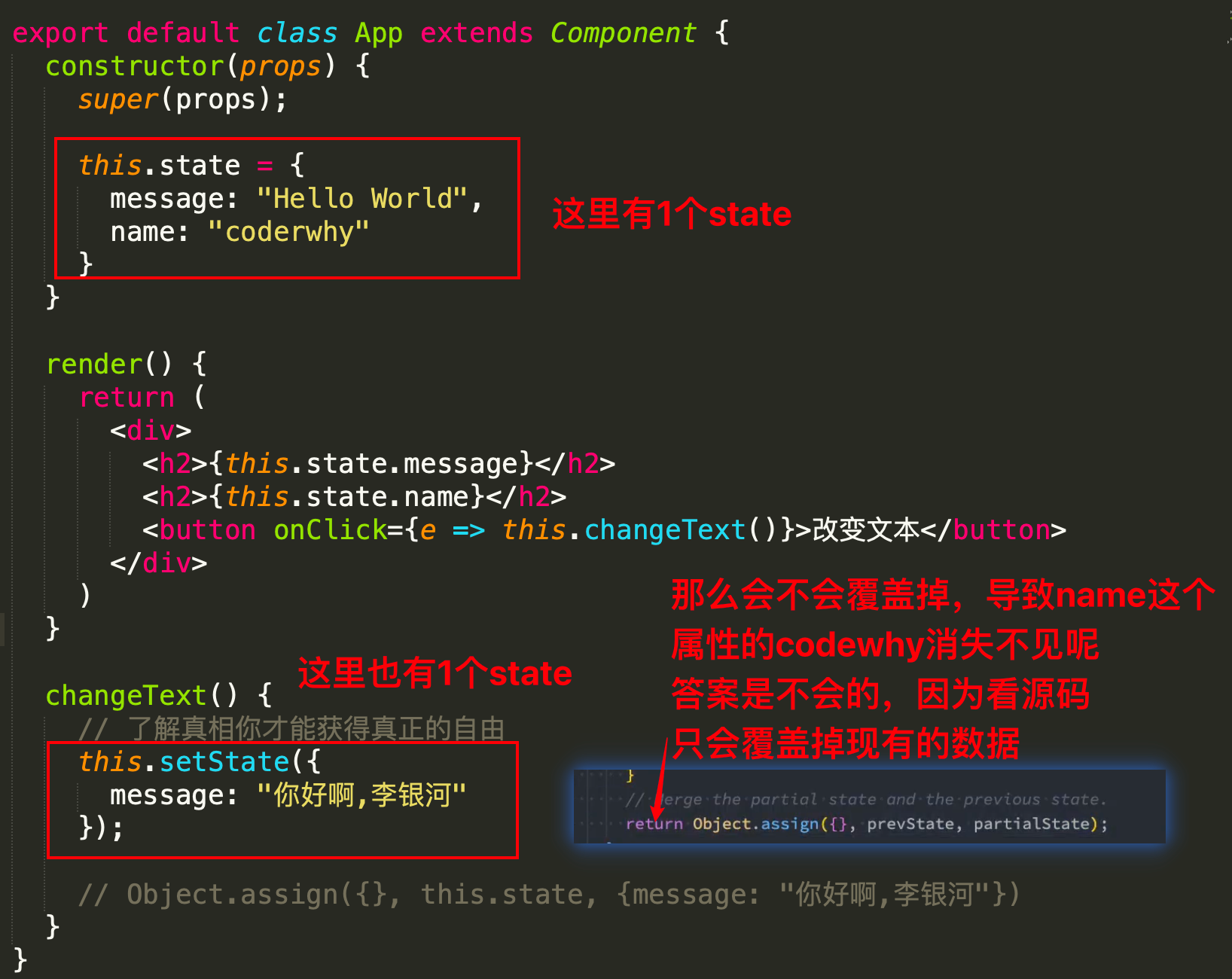
【跟着ChatGPT学React】setState使用起来的注意
setState
前言
在 React 中,setState 是用于更新类组件(Class Component) 状态(state)的核心方法。它可以触发组件重新渲染(re-render),使 UI 发生更新。
1 为什么要使用 setState?
因为要页面发生刷新,即使你修改了一个数据。但只要不调用 setState,就不会进行比较页面渲染。(除非类组件是用this.forceUpdate())
比如下面的这段代码,即使打印出来的this.state.counter已经变了,但是页面也不会重新渲染。
this.state.counter += 1; ❌ 绝对不可以直接在上面修改

只能使用 setState(),这样才会进行虚拟 dom 的比较,然后决定是否刷新渲染。
..... increment() { this.setState({ counter: this.state.counter + 1 // ✅ }); } .....
2 setState 从哪里来的
从上面的代码可以看出来,我们是直接使用this.setState()这个方法的,但是我们并没有定义啊。那么从哪里来的呢?
答案!继承自 Component!
// react/packages/react/index.js export { __SECRET_INTERNALS_DO_NOT_USE_OR_YOU_WILL_BE_FIRED, act as unstable_act, Children, Component, Fragment, Profiler, ..... // react/packages/react/src/ReactBaseClasses.js Component.prototype.setState = function(partialState, callback) { if ( typeof partialState !== 'object' && typeof partialState !== 'function' && partialState != null ) { throw new Error( 'setState(...): takes an object of state variables to update or a ' + 'function which returns an object of state variables.', ); } this.updater.enqueueSetState(this, partialState, callback, 'setState'); };
👆 然后你就可以看到setState()的本体了。
这里的同步和异步其实说的是 🆕 是否可以拿到更新的值。
3 异步更新还是同步更新?
异步更新,是人家 react 的团队大佬说的。why is setState asynchronous
验证如下
import { Component } from 'react'; class State extends Component { constructor(props) { super(props); this.state = { msg: '我是🐱', }; } // ⚠️ 重点看这段代码 handleMsg() { this.setState({ msg: '我是小狗', }); // 如果是同步的话,在上面改成我是小狗之后 // 因为打印的是小狗才对 // 但是点击之后出来的确实小猫 // 这说明并非是按照顺序同步执行的,而是异步执行的 console.log(this.state.msg); // 我是🐱 } render() { return ( <> <h2>{this.state.msg}</h2> <button onClick={(e) => { this.handleMsg(); }} > click </button> </> ); } } export default State;
为什么要用异步呢?大佬是这样解释的。
- 如果每次调用 setState 都进行一次更新,那么意味着 render 函数会被频繁调用,界面重新渲染,这样效率是很低的最好的办法应该是获取到多个更新,之后进行批量更新
- 如果同步更新了 state,但是还没有执行 render 函数,那么 state 和 props 不能保持同步.state 和 props 不能保持一致性,会在开发中产生很多的问题
关于上面这个 state 和 props 的问题,我写一个代码来说明一下。这里设计到父子组件问题
import { Component } from "react"; function Statechind(props) { return <p> {props.msg}</p>; } class State extends Component { ......... // ⚠️ 重点看这段代码 handleMsg() { this.setState({ msg: "我是小狗" }); console.log(this.state.msg); // 我是🐱 } render() { return ( <> <h2>{this.state.msg}</h2> <Statechind msg={this.state.msg} /> ......... </> ); } } export default State;

那么如何拿到异步的结果呢?
方式 1️⃣ setState()回调函数
从 setState 源码里可以看到,这个方法接受 2 个参数。function(partialState, callback)
- 参数 1 function || object
- 参数 2 回调函数 → 当 setState 里的值更新之后,就会触发这个回调函数。利用这个,就可以拿到异步结果。
全部代码如下 ↓
import { Component } from 'react'; class State extends Component { constructor(props) { super(props); this.state = { msg: 'Hello world', }; } handleMsg() { this.setState( { msg: 'Hello REACT', }, // 解决方法1️⃣ 回调函数 () => { console.log(this.state.msg); } ); } render() { return ( <div> {this.state.msg} <button onClick={this.handleMsg.bind(this)}>click to change msg</button> </div> ); } } export default State;
方式 2️⃣,生命周期函数 componentDidUpdate()
因为这个声明周期函数就是在render()之后,页面重新渲染之后才执行的。这样的话,就肯定能拿到。
import { Component } from 'react'; class State extends Component { constructor(props) { super(props); this.state = { msg: 'Hello world', }; } handleMsg() { this.setState({ msg: 'Hello REACT', }); } // 方式 2️⃣ 获取异步更新的state componentDidUpdate() { console.log(this.state.msg); } render() { return ( <div> {this.state.msg} <button onClick={this.handleMsg.bind(this)}>click to change msg</button> </div> ); } } export default State;
🤔 如果 2 个异步获取数据的同时执行,那么是谁先呢?
答案是先执行
componentDidUpdate(),然后setState(更新的setState,回调函数)
4 同步更新(18 之后都是异步了)
在某些情况下其实还是同步的!
下面这段代码需要我在看一下,不然貌似
1️⃣setTimeout()
import React, { Component } from 'react'; export default class App extends Component { constructor(props) { super(props); this.state = { msg: 'hello world', }; } handleMsg = () => { // 1️⃣ 这里使用定时器就是同步的 setTimeout(() => { this.setState({ msg: 'HELLO REACT', }); // 在setTimout的回调函数里输出 console.log(this.state.msg); // HELLO REACT }, 10); };
⚠️ 关于这个 setTimeout 有争议的。18 之后 setState 无论在哪里都是异步的了。所以上面带代码在 React18 里面输出的还是 hello world。
2️⃣ 原生事件
// 组件挂载完 componentDidMount() { // 2️⃣ 渲染之后就使用原生的事件监听 document.getElementById('btn').addEventListener('click', () => { this.setState({ msg: 'HELLO DOMAPI', }); console.log(this.state.msg); }); // ❌ 必须在原始的事件监听里面,直接放在componentDidMount里面是不会 this.setState({ msg: 'HELLO DOMAPI', }); console.log(this.state.msg); }
5 决定同步和异步的本质是?
其实看源码可以找到,react 内部,
同步更新
setTimeout()- 原生事件。
异步更新
- React 合成事件(onClick 这种)
- 生命周期
上面 2 种更新其实是不同的上下文!原生时间的上下文和 react 事件的上下文不同,通过上下文来判断优先等级。判断是同步,异步,批处理。
源码找不到了,反正写在了这里附近。getCurrentPriorityLevel()
6 数据的合并
这里说的是数据的合并,不是 setState 的合并。关于数据是否会被完全覆盖掉的问题。
使用的源码在这里react/packages/react-reconciler/src/ReactUpdateQueue.new.js
// react/packages/react-reconciler/src/ReactUpdateQueue.new.js return assign({}, prevState, partialState);
这里是 Object.assign({}, this.state,{id:uuid99}),MDN 的 Object.assign 说明
Object.assign(target, ...sources); Object.assign({}, this.state, { id: uuid99 }); // 相当于是把后面的全部source,都拷贝到了target{}这里

验证代码
import React, { Component } from 'react'; export default class App extends Component { constructor(props) { super(props); this.state = { id: 'uuid1', msg: 'hello world', }; } handleMsg = () => { this.setState({ // ❓ 这里会不会给完全覆盖掉,导致上面的msg不见,最后显示的只有id呢? // 答案是不会,这里只会先浅拷贝。然后 id: 'uuid99', }); }; render() { return ( <div> <h2>{this.state.id}</h2> <h2>{this.state.msg}</h2> <button onClick={this.handleMsg}>click me</button> </div> ); } }
但是,如果你的数据是一个对象,或者是数组,那么就是会被覆盖的!
为什么会被覆盖的问题的话,这个其实是这样的。
constructor(props) { super(props); this.state = { prim: 'prim', // 简单数据 user: { msg: 'hello world', name: 'chin' }, }; } changeText() { this.setState({ user: { msg: 'hello react' }, }); } // { user: { msg: 'hello react' } } // ⚠️ 最后的结果是没有chin的,因为这里Object.assign 本质是浅拷贝
上面的 setState 就想当于这种感觉了。
const a = { prim: 'prim', // 简单数据 user: { msg: 'hello world', name: 'chin' }, // 复杂类型数据 }; const b = { user: { msg: 'hello react' }, }; const c = Object.assign({}, a, b); console.log(c); // { prim: 'prim', user: { msg: 'hello react' } }
7 本身的合并
如果对于同一个数据使用多次setState()怎么样。
🤔 下面这段代码
increment = () => { this.setState({ counter: this.state.counter + 1, }); this.setState({ counter: this.state.counter + 2, }); this.setState({ counter: this.state.counter + 3, }); }; // 结果是+1还是+3还是+6? // 结果是+3,因为前面的会被后面的给覆盖掉。
setState() 这里的本质也是看源码,会有一个 do/while。所有的 setState 本身会被合并。
如果不想被合并呢?setState()是可以被接受一个函数的,这个函数里面可以接受上一次的值。源码
const nextState = payload.call(instance, prevState, nextProps);
然后根据这个
increment = () => { // 如果是一个函数,会进行累加操作。每一次都会用prevState的值,所以会有累加效果。 this.setState((prevState, props) => { return { counter: prevState.counter + 1, }; }); this.setState((prevState, props) => { return { counter: prevState.counter + 2, }; }); this.setState((prevState, props) => { return { counter: prevState.counter + 3, }; }); };
根据这个就可以判断setState()什么时候需要一个 function,什么时候需要一个 object。
以上 🎉
ChatGPT
下面这些应该是基于最新的 18 说的。(2025.2.21)
1 setState 的基本用法
在 React 类组件 中,组件的状态存储在 this.state,要更新状态,不能直接修改 this.state,必须使用 setState()。
✅ 基本示例
import React, { Component } from 'react'; class Counter extends Component { constructor(props) { super(props); this.state = { count: 0 }; } handleIncrement = () => { this.setState({ count: this.state.count + 1 }); }; render() { return ( <div> <p>当前计数: {this.state.count}</p> <button onClick={this.handleIncrement}>增加</button> </div> ); } } export default Counter;
📌 关键点
-
不能使用 this.state.count++ 直接修改状态,否则不会触发重新渲染。
-
setState() 触发 render() 方法,更新 UI。
2 setState 是异步的
React 不会立即更新 state,而是批量合并多个 setState 调用,以优化性能。
❌ setState 不是立即更新
handleClick = () => { console.log('Before setState:', this.state.count); this.setState({ count: this.state.count + 1 }); console.log('After setState:', this.state.count); // 🚨 这里 count 还是旧的 };
🔍 可能的输出
Before setState: 0 After setState: 0 (不会立即更新)
✅ 解决方案:使用 setState 的回调
this.setState({ count: this.state.count + 1 }, () => { console.log('Updated state:', this.state.count); // ✅ 这里才是最新值 });
3 setState 可能会合并多个更新
React 可能会合并多个 setState() 调用,所以不能直接使用 this.state,而要使用 prevState。
🚨 错误的做法
handleClick = () => { this.setState({ count: this.state.count + 1 }); this.setState({ count: this.state.count + 1 }); this.setState({ count: this.state.count + 1 }); };
🔹 React 可能会优化成
this.setState({ count: this.state.count + 1 }); // 只执行一次更新
✅ 解决方案:使用 prevState
handleClick = () => { this.setState((prevState) => ({ count: prevState.count + 1 })); this.setState((prevState) => ({ count: prevState.count + 1 })); this.setState((prevState) => ({ count: prevState.count + 1 })); };
🔹 这样 count 能正确递增 3 次,而不会被合并。
4 setState 合并对象
setState 只会合并顶层对象,不会合并深层对象。
this.setState({ user: { name: 'Alice', age: 25 } }); this.setState({ user: { age: 26 } }); // ❌ 这样会覆盖整个 `user` 对象
✅ 正确做法(使用 ... 展开运算符):
this.setState((prevState) => ({ user: { ...prevState.user, age: 26 }, }));
5 setState 在函数组件中的替代方案
在函数组件中,不使用 setState,而是使用 useState Hook。
import React, { useState } from 'react'; function Counter() { const [count, setCount] = useState(0); return <button onClick={() => setCount(count + 1)}>点击增加 {count}</button>; } export default Counter;
✅ useState 不会合并对象,所以需要手动合并:
setUser((prevUser) => ({ ...prevUser, age: 26 }));
6 setState 和批量更新
React 18 之后,setState 可能不会合并
useEffect(() => { setCount((c) => c + 1); setCount((c) => c + 1); });
🔹 React 18 之后 count = 2(不再合并)。
✅ 需要触发组件更新时(修改 UI)。
✅ 状态依赖于当前 state 时(使用 prevState 方式)。
✅ 在 useEffect 或 onClick 事件中修改状态。
总结
-
setState 是异步的,不会立即更新 this.state,但可以用回调 setState({}, () => {...}) 获取最新值。
-
多个 setState 可能会被合并,但如果使用 prevState 方式就不会。
-
setState 只会合并顶层对象,深层对象需要手动合并 ...。
-
类组件用 setState,函数组件用 useState。

共有评论(0)